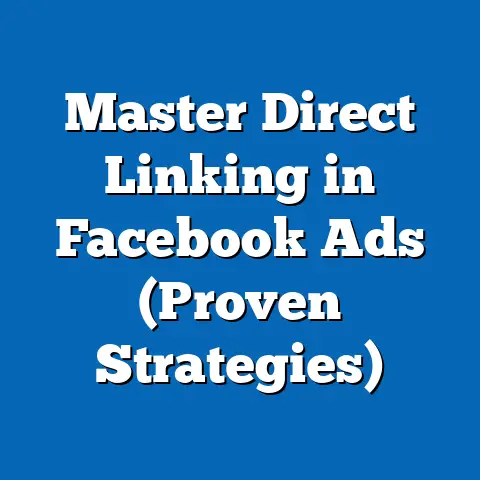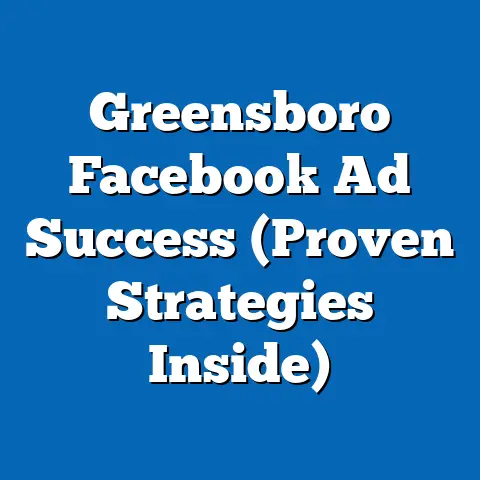Troubleshoot Facebook Marketplace Ads (Expert Solutions)
Ever felt like your Facebook Marketplace ads are shouting into a void? I get it. I’ve been there, staring at dashboards, wondering why my perfectly crafted ad isn’t converting. Sometimes, a quick fix is all you need. Maybe it’s refreshing your campaign settings, ensuring your product images are crystal clear and meet Facebook’s guidelines, or tweaking your targeting just a smidge. These little adjustments can sometimes give your ad the boost it needs.
But let’s be honest, relying solely on quick fixes is like putting a band-aid on a broken leg. It might help in the short term, but it won’t solve the underlying problem. To truly master Facebook Marketplace ads, you need to understand the ins and outs of troubleshooting. This means digging deep, analyzing data, and adapting your strategies based on what the numbers tell you.
In this guide, I’m going to walk you through the most common issues I’ve seen advertisers face on Facebook Marketplace and, more importantly, provide you with expert solutions to overcome them. We’ll go beyond the surface-level tips and delve into the nitty-gritty of optimizing your ads for maximum impact. By the end of this, you’ll be equipped with the knowledge and skills to turn your Marketplace ads into a lead-generating, sales-driving machine. Let’s dive in!
Understanding Facebook Marketplace Ads
Facebook Marketplace has exploded in popularity, becoming a go-to destination for millions seeking everything from vintage furniture to the latest gadgets. As a seller, this presents an incredible opportunity to reach a massive, engaged audience. But it also means you’re competing with countless other businesses vying for attention.
One of the key differences between traditional Facebook ads and Marketplace ads lies in the user intent. People browsing the Marketplace are typically further down the sales funnel, actively looking to buy. They’re not just passively scrolling; they’re searching for specific products and services. This means your ads need to be laser-focused and highly relevant to capture their attention.
Think of it this way: a traditional Facebook ad might be like a billboard on a highway, catching the eye of anyone driving by. A Marketplace ad, on the other hand, is like a listing in a specialized catalog, targeting people who are already interested in what you’re selling.
This difference in intent has significant implications for your advertising strategy. Your ad copy needs to be more persuasive, your visuals more compelling, and your targeting more precise. And that’s where troubleshooting comes in.
In such a competitive environment, even a small hiccup in your ad campaign can have a significant impact on your results. Maybe your ad isn’t showing up in the right place, or your targeting is off, leading to wasted ad spend. Or perhaps your ad copy isn’t resonating with your audience, resulting in low engagement rates. Whatever the issue, identifying and addressing it quickly is crucial for maximizing your ad’s effectiveness.
Troubleshooting isn’t just about fixing problems; it’s about optimizing your ads for peak performance. It’s about understanding what works, what doesn’t, and constantly tweaking your strategy to stay ahead of the curve.
Key Takeaway: Facebook Marketplace offers a unique advertising opportunity, but it also demands a strategic approach. Troubleshooting is essential for maximizing ad effectiveness and staying competitive.
Common Issues with Facebook Marketplace Ads
Over the years, I’ve noticed a few recurring problems that plague Facebook Marketplace advertisers. Recognizing these common pitfalls is the first step towards preventing them from derailing your campaigns. Let’s break down some of the most frequent issues:
-
Ads Not Being Approved or Rejected: This is arguably the most frustrating issue. You spend time crafting the perfect ad, only to have it rejected by Facebook’s review process. This can be due to a variety of reasons, from violating advertising policies to using prohibited content.
- Real-Life Example: I once had a client whose ads for handmade jewelry were consistently rejected. After digging deeper, we discovered that the issue wasn’t the jewelry itself, but the ad copy, which made unsubstantiated claims about the healing properties of certain gemstones.
-
Low Engagement Rates or Impressions: Your ad might be approved, but if it’s not getting any clicks, likes, or shares, it’s essentially invisible. Low engagement rates can stem from a variety of factors, including poor ad creatives, irrelevant targeting, or uncompelling ad copy.
-
Real-Life Example: A local bakery ran Marketplace ads to promote their custom cakes. However, their engagement rates were abysmal. The problem? Their ad creatives featured low-resolution images of poorly decorated cakes. Once they upgraded their visuals with professional-quality photos, their engagement soared.
-
Ads Not Appearing in the Marketplace: This is a particularly insidious problem because you might not even realize it’s happening. Your ads could be approved and running, but for some reason, they’re not showing up in the Marketplace feed. This could be due to incorrect settings, technical glitches, or even Facebook’s algorithm deeming your ad irrelevant to users.
-
Real-Life Example: A furniture store launched a Marketplace campaign to sell their new line of sofas. After a few days, they noticed they weren’t getting any leads. It turned out that they had accidentally excluded the Marketplace placement in their ad settings, effectively preventing their ads from ever appearing in the intended location.
-
Target Audience Mismatch Leading to Poor Performance: Even if your ad is well-crafted and visually appealing, it won’t perform if it’s not reaching the right people. Targeting the wrong audience can lead to wasted ad spend, low conversion rates, and overall poor results.
-
Real-Life Example: A fitness studio ran Marketplace ads to promote their yoga classes. However, they were targeting a broad demographic with little regard for specific interests or preferences. As a result, their ads were reaching people who had no interest in yoga, leading to dismal click-through rates.
Ads Not Being Approved or Rejected: This is arguably the most frustrating issue. You spend time crafting the perfect ad, only to have it rejected by Facebook’s review process. This can be due to a variety of reasons, from violating advertising policies to using prohibited content.
- Real-Life Example: I once had a client whose ads for handmade jewelry were consistently rejected. After digging deeper, we discovered that the issue wasn’t the jewelry itself, but the ad copy, which made unsubstantiated claims about the healing properties of certain gemstones.
-
Low Engagement Rates or Impressions: Your ad might be approved, but if it’s not getting any clicks, likes, or shares, it’s essentially invisible. Low engagement rates can stem from a variety of factors, including poor ad creatives, irrelevant targeting, or uncompelling ad copy.
-
Real-Life Example: A local bakery ran Marketplace ads to promote their custom cakes. However, their engagement rates were abysmal. The problem? Their ad creatives featured low-resolution images of poorly decorated cakes. Once they upgraded their visuals with professional-quality photos, their engagement soared.
-
Ads Not Appearing in the Marketplace: This is a particularly insidious problem because you might not even realize it’s happening. Your ads could be approved and running, but for some reason, they’re not showing up in the Marketplace feed. This could be due to incorrect settings, technical glitches, or even Facebook’s algorithm deeming your ad irrelevant to users.
-
Real-Life Example: A furniture store launched a Marketplace campaign to sell their new line of sofas. After a few days, they noticed they weren’t getting any leads. It turned out that they had accidentally excluded the Marketplace placement in their ad settings, effectively preventing their ads from ever appearing in the intended location.
-
Target Audience Mismatch Leading to Poor Performance: Even if your ad is well-crafted and visually appealing, it won’t perform if it’s not reaching the right people. Targeting the wrong audience can lead to wasted ad spend, low conversion rates, and overall poor results.
-
Real-Life Example: A fitness studio ran Marketplace ads to promote their yoga classes. However, they were targeting a broad demographic with little regard for specific interests or preferences. As a result, their ads were reaching people who had no interest in yoga, leading to dismal click-through rates.
Low Engagement Rates or Impressions: Your ad might be approved, but if it’s not getting any clicks, likes, or shares, it’s essentially invisible. Low engagement rates can stem from a variety of factors, including poor ad creatives, irrelevant targeting, or uncompelling ad copy.
Real-Life Example: A local bakery ran Marketplace ads to promote their custom cakes. However, their engagement rates were abysmal. The problem? Their ad creatives featured low-resolution images of poorly decorated cakes. Once they upgraded their visuals with professional-quality photos, their engagement soared.
Ads Not Appearing in the Marketplace: This is a particularly insidious problem because you might not even realize it’s happening. Your ads could be approved and running, but for some reason, they’re not showing up in the Marketplace feed. This could be due to incorrect settings, technical glitches, or even Facebook’s algorithm deeming your ad irrelevant to users.
Real-Life Example: A furniture store launched a Marketplace campaign to sell their new line of sofas. After a few days, they noticed they weren’t getting any leads. It turned out that they had accidentally excluded the Marketplace placement in their ad settings, effectively preventing their ads from ever appearing in the intended location.
Target Audience Mismatch Leading to Poor Performance: Even if your ad is well-crafted and visually appealing, it won’t perform if it’s not reaching the right people. Targeting the wrong audience can lead to wasted ad spend, low conversion rates, and overall poor results.
Real-Life Example: A fitness studio ran Marketplace ads to promote their yoga classes. However, they were targeting a broad demographic with little regard for specific interests or preferences. As a result, their ads were reaching people who had no interest in yoga, leading to dismal click-through rates.
Neglecting these issues can have serious consequences. Wasted ad spend, missed sales opportunities, and a tarnished brand reputation are just a few of the potential outcomes. That’s why it’s crucial to proactively monitor your ads, identify any problems, and implement effective solutions.
Key Takeaway: Recognizing common issues like ad rejections, low engagement, ad visibility problems, and audience mismatch is crucial for preventing them from derailing your Facebook Marketplace campaigns.
Expert Solutions to Troubleshoot Facebook Marketplace Ads
Now that we’ve identified the common pitfalls, let’s get down to the business of fixing them. Here are some expert solutions to troubleshoot your Facebook Marketplace ads and get them back on track:
- For Ads Not Being Approved:
- Understand the Ad Review Process: Facebook’s ad review process is designed to ensure that ads comply with their advertising policies. This process typically takes a few hours, but it can sometimes take longer, especially for complex or sensitive ads.
- Identify Common Policy Violations: Familiarize yourself with Facebook’s advertising policies, paying particular attention to prohibited content, restricted content, and misleading or deceptive practices. Common violations include promoting illegal products or services, making unsubstantiated claims, and using sexually suggestive or violent content.
- Correct Policy Violations: If your ad is rejected, carefully review the reason for rejection and make the necessary changes to comply with Facebook’s policies. This might involve removing prohibited content, revising your ad copy, or updating your targeting.
- Appeal Rejected Ads: If you believe your ad was rejected in error, you have the option to appeal the decision. Provide a clear and concise explanation of why you believe your ad complies with Facebook’s policies and submit any supporting documentation.
- For Low Engagement Rates:
- Improve Ad Creatives: Your ad creatives are the first thing people see, so they need to be visually appealing and attention-grabbing. Use high-quality images or videos that showcase your products or services in the best possible light.
- Tip: Consider using lifestyle shots that show your products in use, rather than just product shots.
- Craft Compelling Ad Copy: Your ad copy should be clear, concise, and persuasive. Highlight the benefits of your products or services and use a strong call to action to encourage people to click on your ad.
- Tip: Use emotional language and storytelling to connect with your audience on a deeper level.
- Refine Targeting: Make sure your ad is reaching the right people. Use Facebook’s targeting options to narrow your audience based on demographics, interests, behaviors, and other factors.
- Tip: Experiment with different targeting options to see what works best for your audience.
- Improve Ad Creatives: Your ad creatives are the first thing people see, so they need to be visually appealing and attention-grabbing. Use high-quality images or videos that showcase your products or services in the best possible light.
- For Ads Not Appearing:
- Check Ad Settings: Double-check your ad settings to ensure that the Marketplace placement is selected. Also, make sure that your ad is not being excluded from any specific locations or demographics.
- Review Ad Scheduling: Verify that your ad is scheduled to run during the times when your target audience is most active.
- Monitor Ad Delivery: Keep an eye on your ad delivery metrics to see if your ad is being shown to your target audience. If your ad delivery is low, try adjusting your targeting or increasing your bid.
- Contact Facebook Support: If you’ve checked all your settings and your ad is still not appearing, contact Facebook support for assistance.
- For Audience Mismatch:
- Utilize Facebook’s Audience Insights Tool: This tool provides valuable data about your target audience, including their demographics, interests, behaviors, and purchase habits. Use this information to refine your targeting and ensure that your ads are reaching the right people.
- Refine Target Demographics: Narrow your audience based on age, gender, location, education, and other demographic factors.
- Improve Ad Reach: Expand your targeting to include people who are similar to your existing customers. This can help you reach new audiences who are likely to be interested in your products or services.
- Understand the Ad Review Process: Facebook’s ad review process is designed to ensure that ads comply with their advertising policies. This process typically takes a few hours, but it can sometimes take longer, especially for complex or sensitive ads.
- Identify Common Policy Violations: Familiarize yourself with Facebook’s advertising policies, paying particular attention to prohibited content, restricted content, and misleading or deceptive practices. Common violations include promoting illegal products or services, making unsubstantiated claims, and using sexually suggestive or violent content.
- Correct Policy Violations: If your ad is rejected, carefully review the reason for rejection and make the necessary changes to comply with Facebook’s policies. This might involve removing prohibited content, revising your ad copy, or updating your targeting.
- Appeal Rejected Ads: If you believe your ad was rejected in error, you have the option to appeal the decision. Provide a clear and concise explanation of why you believe your ad complies with Facebook’s policies and submit any supporting documentation.
- Improve Ad Creatives: Your ad creatives are the first thing people see, so they need to be visually appealing and attention-grabbing. Use high-quality images or videos that showcase your products or services in the best possible light.
- Tip: Consider using lifestyle shots that show your products in use, rather than just product shots.
- Craft Compelling Ad Copy: Your ad copy should be clear, concise, and persuasive. Highlight the benefits of your products or services and use a strong call to action to encourage people to click on your ad.
- Tip: Use emotional language and storytelling to connect with your audience on a deeper level.
- Refine Targeting: Make sure your ad is reaching the right people. Use Facebook’s targeting options to narrow your audience based on demographics, interests, behaviors, and other factors.
- Tip: Experiment with different targeting options to see what works best for your audience.
- Tip: Consider using lifestyle shots that show your products in use, rather than just product shots.
- Tip: Use emotional language and storytelling to connect with your audience on a deeper level.
- Tip: Experiment with different targeting options to see what works best for your audience.
- Check Ad Settings: Double-check your ad settings to ensure that the Marketplace placement is selected. Also, make sure that your ad is not being excluded from any specific locations or demographics.
- Review Ad Scheduling: Verify that your ad is scheduled to run during the times when your target audience is most active.
- Monitor Ad Delivery: Keep an eye on your ad delivery metrics to see if your ad is being shown to your target audience. If your ad delivery is low, try adjusting your targeting or increasing your bid.
- Contact Facebook Support: If you’ve checked all your settings and your ad is still not appearing, contact Facebook support for assistance.
- Utilize Facebook’s Audience Insights Tool: This tool provides valuable data about your target audience, including their demographics, interests, behaviors, and purchase habits. Use this information to refine your targeting and ensure that your ads are reaching the right people.
- Refine Target Demographics: Narrow your audience based on age, gender, location, education, and other demographic factors.
- Improve Ad Reach: Expand your targeting to include people who are similar to your existing customers. This can help you reach new audiences who are likely to be interested in your products or services.
Example: Improving Engagement with Visuals
Let’s say you’re selling handmade candles. Instead of a generic photo of a candle on a white background, try a lifestyle shot featuring the candle in a cozy living room setting, with soft lighting and other decorative elements. This creates a more emotional connection with your audience and makes your ad more visually appealing.
Key Takeaway: By understanding the root causes of common issues and implementing these expert solutions, you can significantly improve the performance of your Facebook Marketplace ads.
Advanced Troubleshooting Techniques
While the previous solutions address common issues, sometimes you need to dig deeper to truly optimize your campaigns. Here are some advanced troubleshooting techniques I’ve found invaluable:
-
Utilizing Facebook Analytics and Insights for Data-Driven Decision-Making: Facebook provides a wealth of data about your ad performance, including impressions, clicks, conversions, and cost per acquisition. Use this data to identify trends, patterns, and areas for improvement.
- Example: If you notice that your cost per acquisition is higher for a particular demographic, you might want to adjust your targeting or ad copy to better resonate with that audience.
-
A/B Testing Different Ad Formats and Placements: A/B testing involves creating multiple versions of your ad and testing them against each other to see which performs best. This can help you optimize your ad creatives, ad copy, and targeting.
-
Example: Try testing different headlines, images, or calls to action to see which generates the most clicks. You can also test different ad placements, such as the Marketplace feed versus the News Feed, to see which drives the best results.
-
Monitoring Competitor Ads for Inspiration and Benchmarking: Keep an eye on what your competitors are doing on Facebook Marketplace. This can give you valuable insights into their strategies, ad creatives, and targeting.
-
Example: Pay attention to the types of ads your competitors are running, the offers they’re promoting, and the language they’re using in their ad copy. This can help you identify opportunities to differentiate your own ads and stand out from the crowd.
Utilizing Facebook Analytics and Insights for Data-Driven Decision-Making: Facebook provides a wealth of data about your ad performance, including impressions, clicks, conversions, and cost per acquisition. Use this data to identify trends, patterns, and areas for improvement.
- Example: If you notice that your cost per acquisition is higher for a particular demographic, you might want to adjust your targeting or ad copy to better resonate with that audience.
-
A/B Testing Different Ad Formats and Placements: A/B testing involves creating multiple versions of your ad and testing them against each other to see which performs best. This can help you optimize your ad creatives, ad copy, and targeting.
-
Example: Try testing different headlines, images, or calls to action to see which generates the most clicks. You can also test different ad placements, such as the Marketplace feed versus the News Feed, to see which drives the best results.
-
Monitoring Competitor Ads for Inspiration and Benchmarking: Keep an eye on what your competitors are doing on Facebook Marketplace. This can give you valuable insights into their strategies, ad creatives, and targeting.
-
Example: Pay attention to the types of ads your competitors are running, the offers they’re promoting, and the language they’re using in their ad copy. This can help you identify opportunities to differentiate your own ads and stand out from the crowd.
A/B Testing Different Ad Formats and Placements: A/B testing involves creating multiple versions of your ad and testing them against each other to see which performs best. This can help you optimize your ad creatives, ad copy, and targeting.
Example: Try testing different headlines, images, or calls to action to see which generates the most clicks. You can also test different ad placements, such as the Marketplace feed versus the News Feed, to see which drives the best results.
Monitoring Competitor Ads for Inspiration and Benchmarking: Keep an eye on what your competitors are doing on Facebook Marketplace. This can give you valuable insights into their strategies, ad creatives, and targeting.
Example: Pay attention to the types of ads your competitors are running, the offers they’re promoting, and the language they’re using in their ad copy. This can help you identify opportunities to differentiate your own ads and stand out from the crowd.
Continuous learning is also essential. Facebook’s advertising platform is constantly evolving, with new features, updates, and best practices being introduced regularly. Stay up-to-date on the latest changes and adapt your strategies accordingly.
Key Takeaway: Advanced troubleshooting techniques like data analysis, A/B testing, and competitor monitoring can help you unlock even greater potential from your Facebook Marketplace ads.
Conclusion
Troubleshooting your Facebook Marketplace ads is not just about fixing problems; it’s about optimizing your campaigns for maximum effectiveness. While quick fixes can offer immediate relief, a comprehensive approach to understanding and solving issues will lead to sustained success.
Remember, the key to successful Facebook Marketplace advertising is to be proactive, data-driven, and adaptable. By monitoring your ads, identifying problems early, and implementing effective solutions, you can ensure that your campaigns are always performing at their best.
The Facebook Marketplace landscape is constantly evolving, and what works today might not work tomorrow. Embrace the challenge, stay curious, and never stop learning. By doing so, you’ll be well-equipped to navigate the ever-changing world of Facebook advertising and drive consistent results for your business.
Call to Action:
I’d love to hear about your experiences with Facebook Marketplace ads! Share your challenges and successes in the comments section below. And if you found this guide helpful, be sure to follow my blog for more insights and strategies on digital advertising. Together, let’s conquer the Marketplace!





